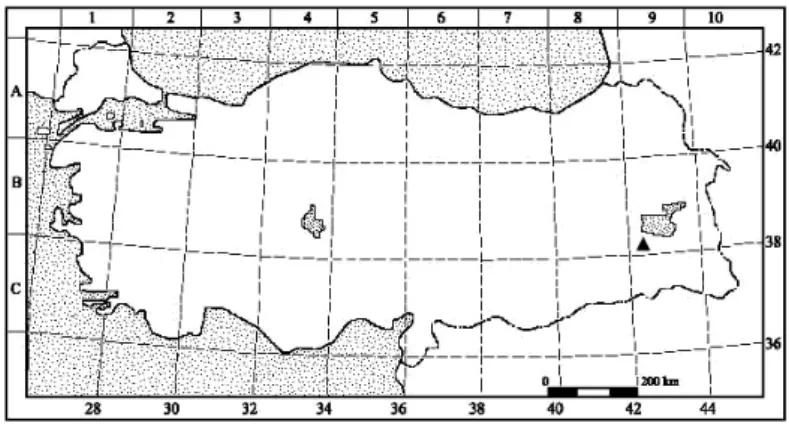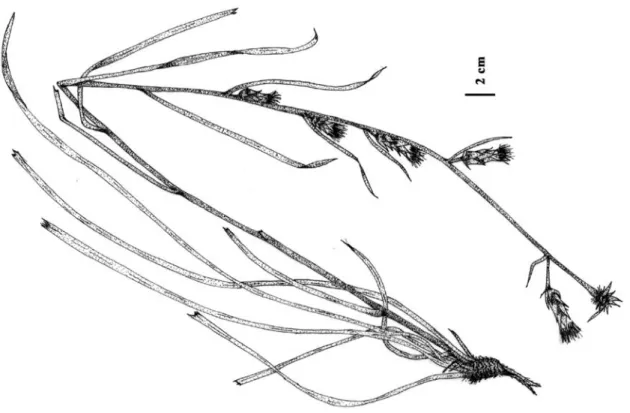www.biodicon.com Biological Diversity and Conservation ISSN 1308-8084 Online; ISSN 1308-5301 Print 3/3 (2010) 133-136
A new record for the flora of Turkey: Scorzonera renzii Rech. f. (Asteraceae) Bekir DOĞAN *1, Ahmet DURAN 2
1
Selçuk University, Education Faculty, Department of Science Education, 42090 Meram-Konya, Turkey 2
Selçuk University, Education Faculty, Department of Biology Education, 42090 Meram-Konya, Turkey
Abstract
Scorconera renzii Rech. f. (Asteraceae) was recently collected from Karz Mountain, Bitlis (East Anatolia) and
it has been reported as a new record for the flora of Turkey. It is described, illustrated and discussed. Key words: Scorzonera, New Record, Turkey
--- ∗ ---
Türkiye florası için yeni bir kayıt: Scorzonera renzii Rech. f. (Asteraceae) Özet
Bitlis Karz Dağından (Doğu Anadolu) toplanan Scorzonera renzii Rech. f. (Asteraceae), Türkiye florası için yeni bir tür olarak kaydedildi. Tür betimlendi, resmedildi ve kısaca tartışıldı.
Anahtar kelimeler: Scorzonera, Yeni Kayıt, Türkiye 1. Introduction
The genus Scorzonera L. (Asteraceae) includes about 180 species widely distributed in the arid regions of Eurasia and Africa (Lack, 2007). The first treatment of Scorzonera is given by De Candolle (1805). According to his system Scorzonera includes perennial herbs and shrubs with simple, entire, rarely pinnatifid leaves, phyllaries always deprived of horns, and seeds mainly without or with hollow pedicels. Considerable changes in the treatment of the genus Scorzonera were introduced by Boissier (1875). In his system the genus Scorzonera includes Podospermum DC. and Epilasia (Bunge) Benth. as sections. The most acceptable system is given by Lipschiz (1935, 1939) which is in many regional “Flora” (Chamberlain, 1975; Chater, 1976; Rechinger, 1977).
According to Chater (1976), the genus Scorzonera is represented with 28 species in Europe and five of them (S. cana (C.A.Mey.) O.Hoffm., S. cretica Willd., S. hispanica L., S. laciniata L., S. mollis M.Bieb.) are also distributed in Turkey (Chamberlain, 1975). Since the revision of the genus Scorzonera by Chamberlain (1975) on behalf of the Flora of Turkey, some other new taxa, such as S. pisidica Hub.-Mor. (Davis et al., 1988), S. latifolia (Fisch. et C.A.Mey.) DC. var. angustifolia Prilipko ex Lipsch. (Güner, 2000), S. sandrasica Hartvig et Strid (Güner, 2000), S.
longiana Sümbül (Güner, 2000), S. adilii A.Duran (Duran, 2002), S. ulrichii Parolly & N. Kilian (Kilian and Parolly,
2002), S. karabelensis Parolly & N. Kilian (Parolly and Kilian, 2003), S. yildirimlii A.Duran & Hamzaoğlu (Duran and Hamzaoğlu, 2004), S. ketzkhovelii Grossh. & Sosn. have been added to the Flora of Turkey (Hamzaoğlu et al., 2010). Fifty Scorzonera species are now known to inhabit in Turkey. In this paper, the new record of Scorzonera species is described and illustrated.
* Corresponding author / Haberleşmeden sorumlu yazar: Tel.: :+903323238220; E-mail: bdogan@selcuk.edu.tr
Bekir DOĞAN et al., A new record for the flora of Turkey: Scorzonera renzii Rech. f. (Asteraceae)
134 Biological Diversity and Conservation – 3 / 3 (2010)
During a field trip in Bitlis, East Anatolia (Figure 1), the authors collected a specimen belong to the genus
Scorzonera . Following a careful examination, it was thought that that it is a new, previously undescribed species.
According to Chamberlian (1975), Chater (1976), Davis et al. (1988) and Güner (2000), Özhatay et al. (1999), Özhatay and Kültür (2006), Özhatay et al. (2009), as well as comparing with specimens in the herbaria E, G, GAZI, HUB, K, KNYA and ANK, the specimen represent a new record for the flora of Turkey. Based on the description in the Flora Iranica (Rechinger, 1977) it keys out as Scorzonera renzii Rech. f. which were examined and compared with specimens of the other related Scorzonera species in Turkey. Selçuk University, Herbarium of the Faculty of Education was abbreviated as MR.
Figure 1. Distribution of Scorzonera renzii (S) in Turkey.
Scorzonera renzii Rech. f., Fl. Iranica. 122: 48 (1977) (Figures 1 and 2).
Type: Persia: Chalil Kuh supra Pesan, 1800-2400 m, 1.VII.1974, Renz in Rechinger 48668 (W, photo!)
Caulescent perennial herb. Root vertical, slender; root collar sparsely covered with brown or straw-coloured leaf sheaths. Stems 35-90 cm tall, 3-4 mm diam. below, 2-5 stemmed, erect, hollow, glabrous, clearly striate, leafy. Leaves graminaceous; basal leaves 20-30 x 0.2-0.3 cm, entire, glabrous, subsessile, greenish, 5-7 veins, apex subfiliform; cauline leaves 10-20 x 0.3-0.5 cm, slightly amplexicaul, gradually diminishing up the stem. Capitula in racemes almost from middle of stem, cylindrical, 2-3 x 0.4-0.8 cm, remote from each other, solitarily borne on short peduncles, peduncles 3-7 mm. Outer phyllaries 0.5-1 x 0.2-0.5 cm, lanceolate to ovate, acute to acuminate at apex, glabrescent or rarely tomentose, margin scarious; inner phyllaries 2-3 x 0.3-0.6 cm, oblong-linear, acute, margin scarious, tomentose tip part. Flowers yellow, ligules longer than inner phyllaries, 10-12 x 1-1.5 mm. Achenes 12-15 x 1-1.5 mm, glabrous, ridged, furrow, cylindrical; pappus 9-12 mm, dirty white, hairs plumose below, scabrid above.
Flowering period July-August, fruiting period August.
Examined specimens: B9 Bitlis: Tatvan, Sapur village, Karz mountain, 1965 m, 38º 26.154' N, 042º 24.413' E, 06 vii 2009, A.Duran 8646 & B.Doğan (MR, GAZI, ANK, HUB).,
2. Conclusions
In Turkey, Scorzonera renzii is distributed in the province of Bitlis (Tatvan, Karz Mountains) in east Anatolia (Figure 3). Iran was previously the only known distribution area of the species (Rechinger, 1977).
Scorzonera renzii grows in calcerous stony slopes of steppe vegetation at 1950-2000 m with Serratula kotschyi
Boiss., Diplotaenia cachrydifolia Boiss., Laserpitium carduchorum Hedge, & Lamond, Tanacetum tomentollum (Boiss.) Grierson, Centaurea saligna(C.Koch) Wagenitz, C. persica Boiss, Achillea vermicularis Trin.
S. renzii is superficially similar to S. elata. It mainly differs from S. elata based on its clear roots thick,
cylindrical (not tuberous), root collar sparsely covered with brown or straw-coloured leaf sheaths (not covered with leaf sheaths); stem unbranched, hollow, 35–90 cm tall (not branched, solid, 30–40 cm tall) and Capitula in racemes (not solitary in the end of the branches). A comparison of S. renzii and S. elata is given in Table 1.
Bekir DOĞAN et al., A new record for the flora of Turkey: Scorzonera renzii Rech. f. (Asteraceae)
Biological Diversity and Conservation – 3 / 3 (2010) 135
Figure 2. Habit of Scorzonera renzii.
Figure 3. Scorzonera renzii. A-habit, B-capitula.
Bekir DOĞAN et al., A new record for the flora of Turkey: Scorzonera renzii Rech. f. (Asteraceae)
136 Biological Diversity and Conservation – 3 / 3 (2010)
Table 1. A comparison between the diagnostic characters of Scorzonera renzii and S. elata
Characters Scorzonera renzii Scorzonera elata
Root thick, cylindrical tuberous
Root collar covered with leaf sheaths not covered with leaf sheaths Stem hollow, unbranched, 35–90 cm tall solid, much branched, 30–40 cm tall Basal leaves 20-30 cm long,, 2-3 mm wide 5-20 cm long, 1–2 mm wide
Capitula in racemes solitary in the end of the branches
Achene 12–15 mm long c. 8 mm long
However, Scorzonera renzii, which was known as endemic to Iran, lost this characteristic after it was collected from Turkey. This species is rare in Turkey and only known from one locality (Bitlis, Tatvan, Karz mountains). The population is in a poor condition and numbers of individuals is estimated to approximately 120-125. By considering its narrow distribution area, Endangered (B2a) conservation status is proposed (IUCN, 2001).
References
Boissier, E. P. 1875. Flora Orientalis. Composees. 3: 151– 883. Candolle, A. P. De, 1805. Flore Francaise, Paris, 4: 61.
Chamberlain, D.F. 1975. Scorzonera L., pp. 632–657. In: Davis, P. H. (Ed.), Flora of Turkey and the East Aegean Islands, Vol. 5. Edinburgh Univ. Press, Edinburgh.
Chater, A. O. 1976. Scorzonera L., pp. 317–322. In: Tutin, T. G., Heywood, V. H., Burges, N. A.,Valentine, D. H.,Walters, S. M. & Webb, D.A. (Eds.), Flora Europaea, Vol. 4. Cambridge Univ. Press, Cambridge.
Davis, P. H. Mill, R. R. & Tan, K. 1988. Scorzonera L., pp. 169–170. In: Davis, P. H., Mill, R. R., Tan, K. (Eds.), Flora of Turkey and the East Aegean Islands (Supplement). Vol. 10. Edinburgh Univ. Press, Edinburgh.
Duran, A. 2002. A new species of Scorzonera L. (Asteraceae) from Anatolia, Turkey. Pakistan Journal of Botany. 34(3): 385–389.
Duran, A., Hamzaoğlu, E. 2004. A new species of Scorzonera L. (Asteraceae) from South Anatolia, Turkey. Biologia. 59: 47–50.
Güner, A. 2000. Scorzonera L., pp. 167. In: Güner, A., Özhatay, N., Ekim, T., Başer, K. H. C. (Eds.), Flora of Turkey and the East Aegean Islands (Supplement), Vol. 11. Edinburgh Univ. Press, Edinburgh.
Hamzaoğlu, E., Aksoy, A., Martin, E., Pınar, N.M., Çölgeçen, H. 2010. A new record for the flora of Turkey:
Scorzonera ketzkhovelii Grossh. (Asteraceae). Turkish Journal of Botany. 34: 57-61.
IUCN. 2001. IUCN red list categories, ver. 3.1. – IUCN Species Survival Commission.
Kilian, N., Parolly, G. 2002. Scorzonera ulrichii Parolly & N. Kilian, sp. nova. In: Greuter W & Raus T (eds.), Med– Checklist Notulae, 21. Willdenowia. 32: 198–200.
Lack, H.W. 2007. Tribe Cichorieae Lam. & DC.– In: Kubitzki (ed.): The Families and Genera of Vascular Plants, Vol. VIII, Flowering Plants. Eudicots, Asterales: Kadereit & Jeffrey (eds.): 180-199. Heidelberg, Berlin: Springer-Verlag.
Lipschitz, S.J. 1935. Fragmenta Monographiae Generis Scorzonera. Transactions of the Rubber and Guttapercha Institute, Moscow, 1: 1–164. (in Russian)
Lipschitz, S. J. 1939. Fragmenta Monographiae Generis Scorzonera. Soc. Nat. Curiosiorum Mosquensis, Moscow, 2: 1– 165. (in Russian)
Özhatay, N., Kültür, Ş., Aksoy, N. 1999. Check-list of additional taxa to the supplement flora of Turkey II. Turkish Journal of Botany. 23: 151–170.
Özhatay, N., Kültür, Ş. 2006. Check-list of additional taxa to the supplement flora of Turkey III. Turkish Journal of Botany. 30: 281–316.
Özhatay, N., Kültür, Ş., Aslan, S. 2009. Check-list of additional taxa to the supplement flora of Turkey IV. Turkish Journal of Botany. 33: 191–226.
Parolly, G., Kilian, N. 2003. Scorzonera karabelensis Parolly & N. Kilian (Compositae), a new species from SW Anatolia, with a key to the subscapigerous Scorzonera species in Turkey. Willdenowia. 33: 327–335.
Rechinger, K. H. 1977. Genus Scorzonera L. Flora Iranica. 122: 16–83.


